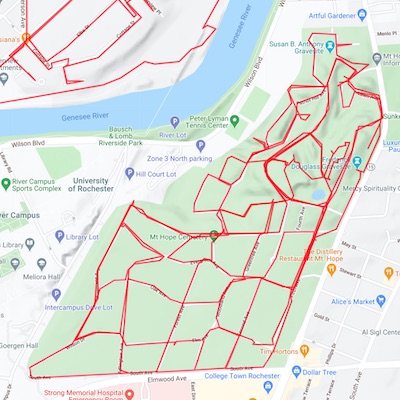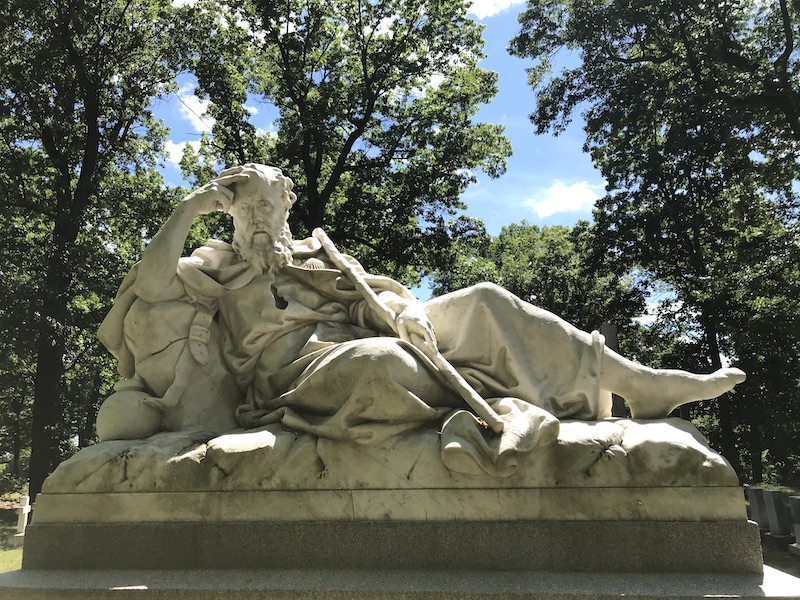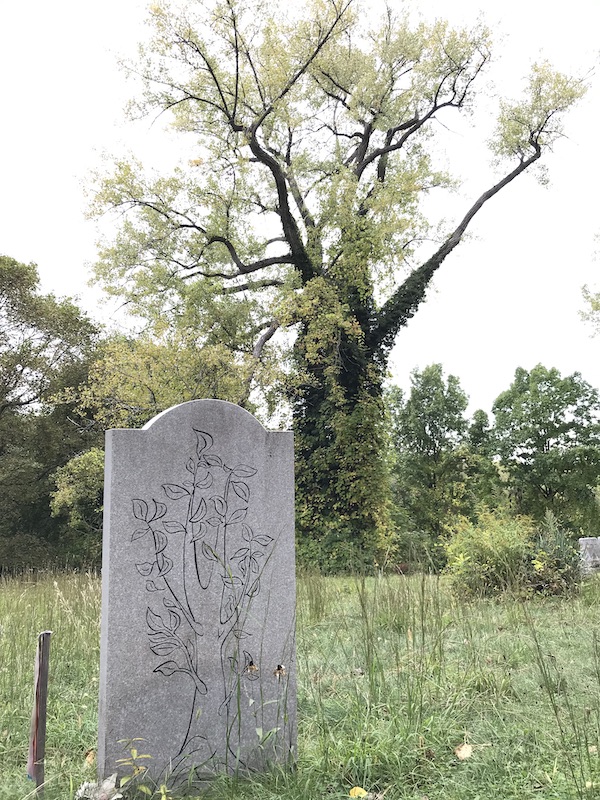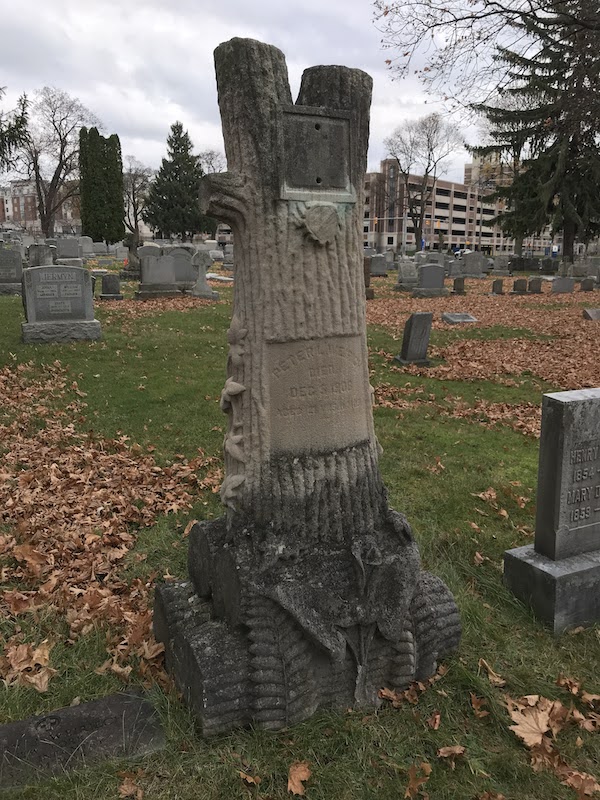Mount Hope Cemetery

Year Incorporated: 1838
Ward: 14
Population: 0 for census purposes
Distance traveled: 13.82 miles[/su_box]
With over two hundred times the population density of the rest of Rochester, this place is also known for its quiet residents. With 196 acres of land and roughly 370,000 burials, Mount Hope Cemetery also boasts the status of “first municipal cemetery” in the nation, as well as possibly being the first racially integrated municipal cemetery* in the U.S. Scores of notable figures in our city’s history are laid to rest here, alongside so many more of our ancestors, named and anonymous.
The genesis of Mount Hope stemmed from a trend in the 1830s towards rural cemeteries, which at the time addressed the immediate concern of how to handle the rampant spread of “Genesee Fever” and cholera, among other often fatal maladies. Drawing inspiration from new rural cemeteries in New Haven, CT and Boston, MA, ours was the first to be sponsored by the city itself. With the booming population came both a need for burial sites and real estate, and because of this early cemeteries were often temporary. One example was the Sophia Street Cemetery, located where the Monroe County Jail is now. Once a sacred burial site for the city’s early pioneers, it soon stood in the way of progress and was moved to West Main Street, at least until that site was selected for the new General Hospital. Many of those early graves made their third and final stop at Mount Hope which, due to the city’s support, were no longer under threat of relocation. This is why you may occasionally see headstones dated as far back as 1799.

Rochester, under the direction of our 3rd mayor Abraham Schermerhorn, went shopping for a site in 1836. One of the final contenders was a large parcel on the western shore of Irondequoit Bay, but ultimately a 50-acre tract owned by Silas Andrews was selected. Mr. Andrews was paid $5386, which seems low even after inflation ($151,000 in today’s dollars – then again, this was out in the middle of the country in 1836). An additional $8000 was allocated for improvements, and within several months the site was ready for the public.
Many more improvements took place in the following years. George Ellwanger and Patrick Barry donated 50 trees in 1847, which would mark the beginning of the site’s reputation as an arborist’s paradise. The chapel and crematorium in the north section was built in 1862. The gazebo came in 1872, followed by the Andrew J. Foster-designed gatehouse in 1874, and the iconic fountain a year later. In 1912 the larger chapel in the south section was added. In 1974 the land was recognized with a nomination to the National Register of Historic Places. 1980 saw the founding of the Friends of Mount Hope Cemetery, whose mission is “to restore, preserve, and encourage public use and enjoyment of this unique historical treasure.”

The most unusual event to ever occur within the confines of the cemetery happened on April 16th, 1871 atop a structure known as The Fandango. Located near the highest point in the cemetery (in Section I, near the grave of Johnny Baker and not in the kettle in section G – that was a water tower) scores of people lined up to climb to the top of the wooden tower which typically offered a bird’s eye view of the city. On this day their view was quite different. Many witnesses reported a clear view of Rice Lake in Ontario, roughly 80 miles north of their current location. Due to an atmospheric trick known as Fata Morgana the distant coast seemed to be within walking distance. The Fandango, built of wood and subject to Rochester winters, likely only survived about two decades and was never replaced, though I suspect the right conditions for Fata Morgana do occur on occasion, and if a high enough vantage point were located we may once again experience The Rochester Mirage.
Shortly after the cemetery opened a poem was published in The Knickerbocker, or New York Monthly Magazine, known as the most influential literary publication of the era. Penned by author (and great-grandmother to the Koch Brothers) Elizabeth Clementine Stedman, it reflects the reverence high society had for this place even in its earliest years.
"MOUNT HOPE CEMETERY, ROCHESTER" By Mrs. E. C . Stedman. As appears in the 1840 issue of The Knickerbocker. I. Come hither, ye who fear the grave, and call it lone and drear, Who deem the burial-place a spot to waken grief and fear; Oh! come and climb with me this mount, where sleep the silent dead, And through these winding gravel-walks, with noiseless footstep tread. II. Stoop down and pluck the fragrant hud, just opening fresh above The peaceful bed, where slumbers one who died in youth and love; Smell the pure air, so redolent with breath of summer flowers, And take this sprig of evergreen, a pledge for future hours. III. See yonder river sparkling through the foliage of the grove, How gracefully its course doth bend how still its waters move! Sit 'neath the branches of this tree, which spread their grateful shade, To screen a spot for musing thought, or holy converse made. IV . Look round this garden of the dead, where creep green myrtle vines, Where 'box' surrounds the sleeper's home, and scented sweet-brier twines; Where lowly violets ope to heaven their tiny eyes of blue, Filed oft at morn with glittering tears, the drops of early dew. V. And now bend upward still your steps, to gain the highest peak, And let your eyes the view beneath, and distant prospect, seek ; O, beautiful! thrice beautiful! - there blended hill and dale, And here the lofty mansion, with cottage of the vale! VI. The city spires, which look to Heaven, in whose high cause they stand, As guides to point the pilgrim's eye toward the far promised land; The distant villages that speck with white the wavy green, And farther still, the deep blue lake, with many a sail is seen. VII . Descend again, and pause beside this vine-encircled tomb; And tell me, is there aughtaround to fill the heart with gloom? List to the feathered songsters' notes, that warble from the trees, And hear the music soft that steals upon the whispering breeze! VIII. Oh! say, do not fair Nature's tones awake the soul to bliss? And does not thought ascend to heaven from such a spot as this? And e'en the grave, doth not its voice, amid such flowery ground, Say to the weary sons of earth, 'Here sweet repose is found?' IX . Mount Hope! thy consecrated walks I never more may tread, And learn to die, by conning here the lessons of the dead; Yet sweet 't would be to 'rest my flesh in hope' beneath thy sod, Till the last trump should bid it rise, to see a Father, God! [The Knickerbocker; Or, New-York Monthly Magazine, Volume 16]

This post was borne from a shorter piece I had written on the Erickson/Perkins family grave. The plot itself, located atop a hill in section G, is recognizable from the Italian-made marble sculpture featured at the center known as “The Weary Pilgrim” or sometimes “The Weary Traveller”. The Erickson and Perkins family, joined by marriage, were known for both the founding of the Rochester School For the Deaf and the American Association of University Women. Of course there are hundreds of thousands of stories buried within the cemetery, but for the sake of avoiding carpal tunnel surgery I’ll list only a handful more who piqued my interest:

- The Douglass Family – Frederick, the famed abolitionist, statesman, author, publisher and 19th century activist. His wives Anna Murray, a conductor on the underground railroad, passed away when Frederick was 64. He then married Helen Pitts, an abolitionist and suffragist. Annie, the daughter of Frederick and Anna, died at 10 years of age and was buried in this plot.
- Cynthia Fitzpatrick – born on Christmas day in 1864, she died February 22nd, 1983. Try not to let your jaw drop when you do that math. Her obituary was printed all around the nation, and if not for her missing birth records would’ve beaten the prior oldest-person record by two years.
- Susan B. and Mary Anthony – Leaders in the Women’s Suffrage movement, as well as anti-slavery and temperance movements.
- Ida Jane Anderson – The mother of registered nursing, she proposed the first standards used to license nurses, and herself became the first registered nurse in New York in 1904.
- Burrell & Maria Reed – Pioneers of the Rochesterville settlement, and Rochester’s first barbershop owner (1818). Their son Austin Reed was the author of the first prison memoir written by a Black author.
- Myron Holley – founder of the Liberty Party, abolitionist, state assemblyperson, founder of the Unitarian church in Rochester, instrumental in directing the new Erie Canal through Rochester, and the man credited with attracting Frederick Douglass to our city. Holley also held the record for the largest funeral gathering at Mount Hope Cemetery, at over 6000 living mourners.
- Frank Stewart – Dying at the young age of 33, Frank managed to live a full life as a Civil War veteran, baseball player and captain of the Unexpected (the first Black baseball team in town), as well as a firefighter with the volunteer Protectives.
- Franciszek Salezy Wolowski – A justice of the Supreme Court of Poland. Wolowski arrived with the first wave of Polish immigrants to Rochester in the 1850s.
- Charlotte Bristol and Georgiana Simms – two enslaved sisters who found freedom thanks to the Underground Railroad and Harriet Tubman.
- George Selden – the inventor of the gasoline-powered automobile, and one of many to be swindled by Henry Ford.
- Reverend Thomas James – He escaped enslavement at 18 and eventually made it to Rochester, where he built the original AME Zion Church. He was the first to organize an anti-slavery society locally.
- Johnny Baker and the Cody children – Buffalo Bill Cody, famed cowboy, once called Rochester home. Tragedy struck the family and 3 of his children are buried here. Baker, who was known as Cody’s foster son, is also buried here.
- Edwin A. Robinson, MD – He was the first African American to graduate from the University of Rochester’s medical program.
- David Wycoff and family – The senior Wycoff delivered the Address of the Colored People in 1846 calling for an end to injustices toward Black persons and extension of the right to vote. His son, David E. Wycoff, was a Sergeant in the 108th Volunteer Infantry.
- Hiram Sibley – The founder of Western Union and one of the primary champions of Alaska’s annexation.
- Isaac and Amy Post – They were very active on the Underground Railroad as well as prominent suffragists.
- Mildred Wright – A 6-year-old girl who died in the infamous Orphan Asylum fire of January 8, 1901.
- Lewis Henry Morgan – known as the father of American anthropology.
- Algernon and Adelaide Crapsey – the elder was a clergyman in St. Episcopal Church, and was removed in a very controversial heresy case. Adelaide, his daughter, was a prominent and accomplished poet.
- Ferdinand Cunningham – After a distinguished three year enlistment in the Union army, Cunningham eventually moved to Rochester and became a barber, Mason, community advocate, and colleague of Frederick Douglass. Cunningham would later lead in the effort to erect the monument to his friend, the first memorial to a Black person in the U.S.
- Charles Lunsford – The first Black licensed physician in Rochester.
- Margaret Woodbury Strong – what happens when a toy collector becomes a philanthropist? She is the reason Rochester has the Strong Museum of Play.
- Theodore Lancaster – One of the revered Tuskegee airman, earning the rank of 2nd Lieutenant. Later he would serve in the Cold War, stationed in Alaska as part of a missile defense program.
- Thomas Boyde, Jr. – The city’s first Black architect and designer of large portions of the Monroe Community Hospital.
- Frank Gannett – the publishing magnate behind a large portion of news media in New York state.
- Patricia Curtis Thompson – The first Black woman to break the color barrier within the Rochester Police Department and become sergeant.
- William Warfield – Eastman School of Music alum, World War II vet, and world famous singer.
Mount Hope is a place to mourn, for sure, but it’s also a place to walk, picnic, bird-watch, or simply learn. Rochester’s past resides here, and it’s alive and well in the monuments, old buildings and inscriptions on the headstones. Its present is impressive, too. I spend plenty of time volunteering during the summer, maintaining the Perkins/Erickson plot in section G. Every time I head over there in the spring and summer months it buzzes with the energy of gardeners tending to cradle graves. When it’s quiet I watch the woodchucks burrow, or the deer forage for food. Often in the fall the crows will roost overhead. It is truly a resting place, both for the deceased and the living.
I’ve attempted to capture, to the best of my ability, Mount Hope in all four seasons. Let me know if you have a favorite image, or if I neglected to capture your favorite spot in the cemetery.
*Many of the facts here are taken from Beyond These Gates: Mountains of Hope in Rochester’s African-American History by Marilyn S. Nolte and Verdis L. Robinson. Mt. Hope’s status as first integrated municipal cemetery was mentioned by Mr. Robinson as a possibility during a Zoom presentation on February 13, 2021. This claim, while plausible, deserves further research.
Also heavily referenced: Reisem, R. and Gillespie, F., 2010. Frederick Douglass and the Underground Railroad. Rochester, NY: Friends of Mount Hope Cemetery.





















Another amazing article about Rochester’s history. Kudos!Kenneth Rowe
Outstanding article
Jay, this is a wonderful article! You definitely shared some on the amazing stories. You are a such a valued visitor to our wonderful Cemetery. We, the Friends of Mount Hope, must get you on board with us as I’m sure it would be a wonderful relationship!
I am currently a member of FOMH – feel free to reach out if you’d like to do anything else!